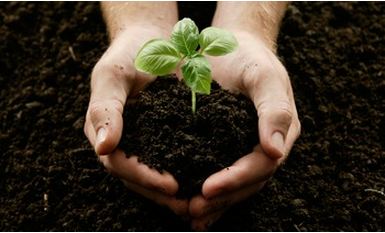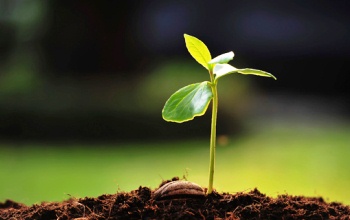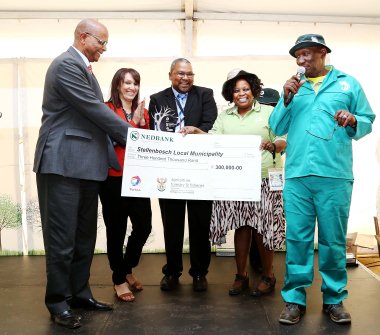Let's Plant for the Future During Arbor Week 2014
 Why Are Trees and Plants Important?
Why Are Trees and Plants Important?
We all know we can't live without water, but we seldom give a second thought to the air we breathe. Trees and plants purify our air and provide us with oxygen, which is essential to almost all living creatures on our planet. The more trees we plant, the better the quality of the air we breathe.
How did Arbor Day Evolve into Arbor Week?
South Africa celebrated its first Arbor Day in 1983. However, in 1999, the national government of South Africa made the decision to extend the day-long celebration into National Arbor Week to emphasise the importance of trees in our modern environment.
The campaign has evolved into a major event that receives major publicity and public participation throughout South Africa. The Department of Agriculture, Forestry and Fisheries (DAFF) is the custodian of the greening function in South Africa and as such, is responsible for the co-ordination of the Arbor Week Campaign in partnership with local government institutions, non-government organisations and community-based organisations.
The idea is to highlight the opportunities for sustainable environmental, social and economic development, community participation, poverty alleviation and job creation in forestry, thereby contributing towards growth, development and a better life for all.
Every Arbor Week celebration highlights two or three specific trees, one common and one rare species. In 2014 the trees being highlighted are:
- Common: Lavender Trees or Laventelbome (Genus Heteropyxis)
- Rare: White Ironwood or Witysterhout (Vepris lanceolata)
What Are the Objectives of Greening the Country?

Greening refers to an integrated approach to the planting, care and management of all vegetation in urban and rural areas to secure multiple benefits for communities. Greening in the South African context takes place in towns, townships and informal settlements specifically because in the past, previously disadvantaged areas were not catered for in terms of planning for parks or planting trees in streets and open spaces.
National Arbor Week affords the department and other stakeholders the opportunity to undertake a major national awareness programme regarding the value of trees in our lives and creating awareness of tree species threatened by extinction.
The theme for the 2014 Arbor Week Campaign is Forests and People: Investing in a Sustainable Future and was adopted from the World Forestry Congress, which will be hosted by South Africa in Durban in 2015. This year's campaign will be a platform to promote the congress and to highlight the value and importance of forests.
The 2014 campaign promotes awareness for the need to plant and maintain indigenous trees throughout South Africa, especially for the many disadvantaged communities who often live in barren and water-stressed areas. It further intends to:
- Raise awareness of South Africa’s urban and rural greening initiatives.
- Promote a better understanding of trees, particularly indigenous trees and fruit trees.
- Highlight the important role that trees play in the sustainable development and livelihoods of people and their environment.
- Highlight the role of trees in creating employment, especially in rural areas.
- Highlight the role of fruit trees in addressing food security when integrated with other programmes.
- Encourage communities to participate in various greening activities within their own surroundings.
What is the Arbor City Awards?
The Arbor City Awards competition was re-introduced in 2002 and is a joint initiative between the Department of Agriculture, Forestry and Fisheries (DAFF) in conjunction with the Institute of Environment and Recreation Management (IERM). The main aim was to recognise and provide incentives for towns, cities and municipalities for their greening efforts, with the special focus on previously disadvantaged areas, such as townships and informal settlements.
The competition provides for two categories of winners namely, the metropolitan municipalities and local municipalities. For each category, the winning municipality will receive prize-money.
Since 2010 the Arbor City Awards competition has been conducted nationally. This was in response and reaction to a ministerial directive. The following municipalities have won the coveted first prizes since 2010:
- 2010 Drakenstein Municipality (Local municipality category)
- 2011 Drakenstein Municipality (Local municipality category)
- 2012 Johannesburg Metropolitan Municipality (Metropolitan municipality category)
- 2012 Khara Hais Municipality (Local municipality category)
- 2013 eThekwini Municipality (Metropolitan municipality category)
- 2013 Drakenstein Municipality (Local municipality category)
- 2014 Stellenbosch Municipality (Local municipality category)
- 2014 eThekwini Municipality (Metropolitan municipality category)
Through this competition, municipalities are encouraged to undertake greening initiatives, develop greening plans, to expand greening projects in previously disadvantaged areas, ensure that municipalities comply with relevant legislation regarding greening and to raise awareness of the importance and value of greening in communities.
The 2014 Arbor City Awards ceremony will be taking place at Mofolo City Park, Soweto on 1 September 2014. To win, municipalities had to fulfil a number of requirements; among these were a portfolio of evidence showing a greening policy or strategy, a tree register, maintenance plans and budget; a portfolio of evidence in videos or pictures depicting projects, sites, and special trees.
 The 2014 winner of the local municipality category, Stellenbosch Municipality, will be concluding its Arbor Week festivities by celebrating its victory, as well as the Million Trees Project's first year on Friday, 5 September 2014, at the Jan Marais Nature Reserve in Stellenbosch.
The 2014 winner of the local municipality category, Stellenbosch Municipality, will be concluding its Arbor Week festivities by celebrating its victory, as well as the Million Trees Project's first year on Friday, 5 September 2014, at the Jan Marais Nature Reserve in Stellenbosch.
The key focus of the Million Trees Project is to provide dignified living spaces for all, thus sharing the environmental, social and economic benefits. Pressures of development and urbanisation often cause an imbalance in nature which we can correct by planting trees.
The project is a collective effort with the public to plant avenues, sidewalks, parks, recreational spaces, cemeteries and, wider than that, any privately owned land.
Another key focus of this community-based project is to "green the townships" by planting up the informal settlements and other areas previously not greened and those where high density developments prevented the planting of trees.
“Stellenbosch is a very proud town today, a very proud community”, says Mayor Conrad Sidego. "This award (Arbor City Award for Local Municipality 2014) did not just happen to come our way come. We worked hard and creatively to achieve this and the Million Trees Project is one of a number of innovative projects that drives us and motivates us to increase the quality of life of everyone in the greater Stellenbosch community. The challenge now is to build on this performance, and remain the greenest city and municipality in South Africa", according to Mayor Sidego.



